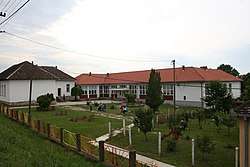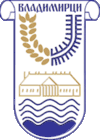Debrc
Debrc (Serbian Cyrillic: Дебрц) is a former town, today a village, located in the Vladimirci municipality in Mačva District of Serbia. According to the census from 2011 there were 858 people listed in the village (according to the previous censuses number of inhabitants was somewhat larger: 875 in 2002, and 890 in 1991).
Debrc Дебрц | |
|---|---|
 | |
 Debrc | |
| Coordinates: 44°37′14″N 19°54′07″E | |
| Country | |
| District | Mačva |
| Municipality | Vladimirci |
| Elevation -above sea level | 140 m (460 ft) |
| Population (2011 census) | |
| • Total | 858 |
| Total listed population | |
| Time zone | UTC+1 (CET) |
| • Summer (DST) | UTC+2 (CEST) |
| Postal code | 15214 |
| Area code(s) | +381 15 |
| Vehicle registration plate | ŠA |
Name
Name of the settlement originates from the Middle Ages, when a castle of Serb king Stefan Dragutin was located in this settlement. In Hungarian language, the settlement was known as Debrecen. There is also a city in Hungary with same name (see: Debrecen) and names of both places are of Slavic origin.
History

During the rule of Serb king Stephen Dragutin (end of the 13th century), Debrc was the capital of his realm between 1276 and 1283.
Afterwards, the area of Mačva became disputed between the Serbian states and the Kingdom of Hungary. Debrc was part of several Serbian states (the Serbian empire, the State of Nikola Altomanović, the Moravian Serbia, and the Serbian Despotate), before been conquered by the Ottoman Empire. In 1718-1739, it was part of the Habsburg Kingdom of Serbia, but was again conquered by the Ottomans in 1739. Since 1804, Debrc is part of modern Serbian state.

In 1892 in the town were established modern school named Jovan Cvijic. The school building were constructed in 1910.[1] In 1939 Orthodox Church Saint Constantine and Helena were build.[2]
Features
The community Debrc is one of the largest and most important in the municipality of Vladimirci. In this community there are many significant infrastructure facilities for the life of its citizens, such as: Local office, health center with pharmacy, eight-year school with a gymnasium and a modern library, nursery, veterinary stations, etc.

